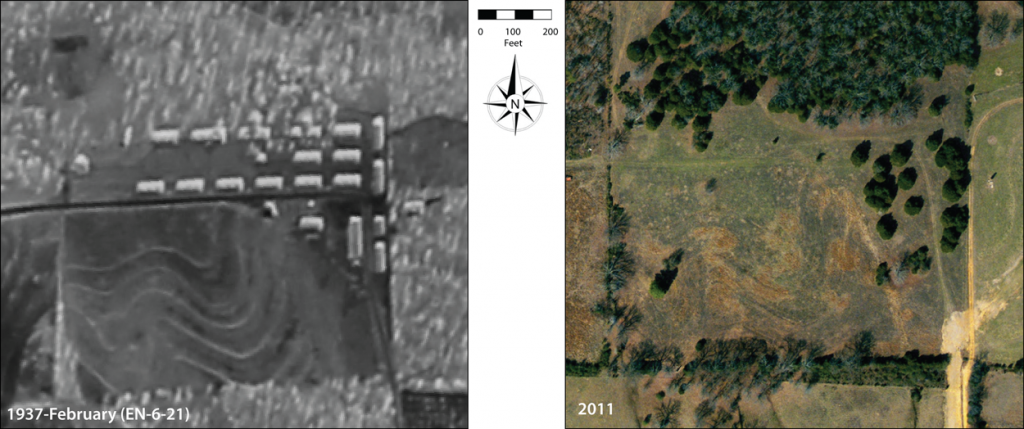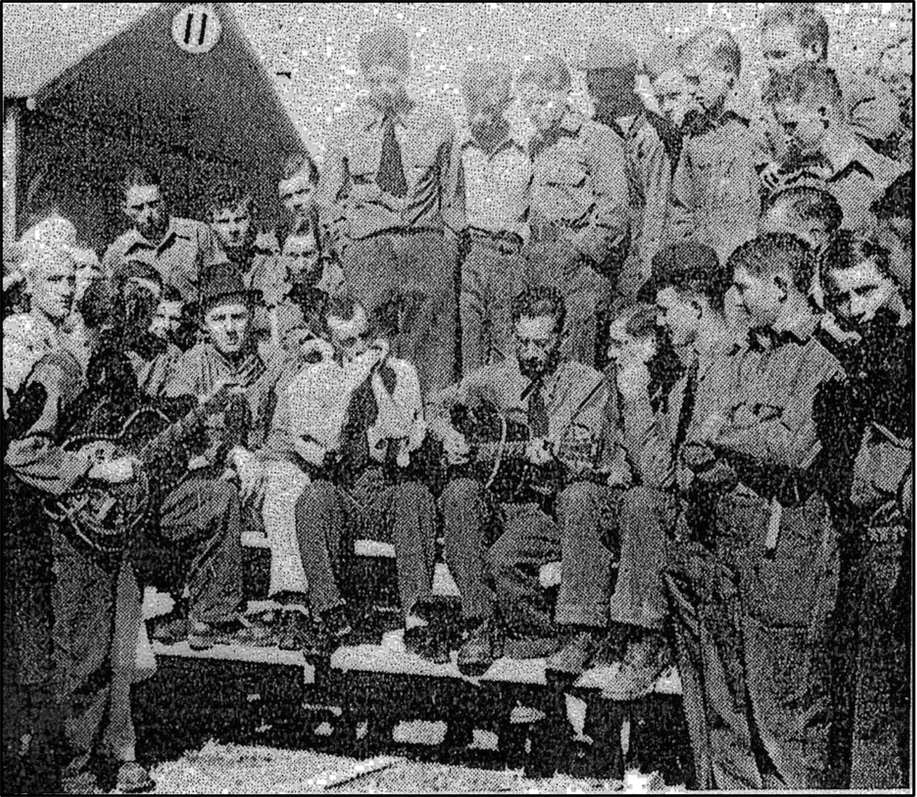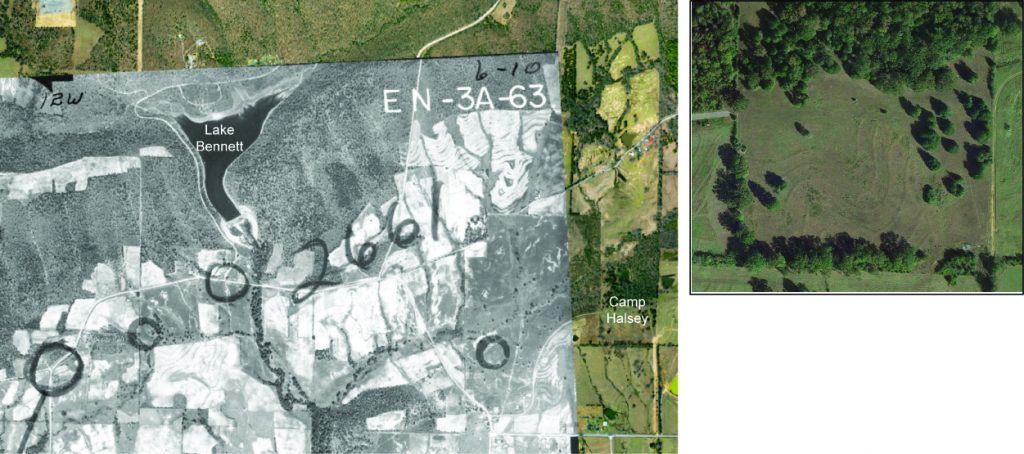Camp Halsey (3FA313)
After expansive droughts in the early twentieth century, funding went to “demonstration projects,” which involved a multifaceted approach to conserving soil within an area coterminous with a watershed. The Cadron Creek Demonstration Project of 1934 was one of the first of these projects in Arkansas. Headquartered and managed out of Conway, the Cadron Creek Demonstration Project was not affiliated with a residential camp. However, with the creation of the CCC, federal officials ensured that demonstration project areas received one or more residential camps to assist participating farmers with the labor-intensive parts of soil conservation. Soil Conservation Service camps (as part of the CCC) were created in 1933-34 to facilitate this need. In Faulkner County, Camp Halsey is a result of this need and was one of numerous camps supporting the Cadron Creek watershed project under the control of the Soil Conservation Service.

Camp Halsey was built in August and September of 1934 and formally occupied on October 1, 1934 by men who transferred from Camp Victor, an Ozark forestry camp in Pope County. Camp Halsey was established as SCS 1, Company 1706. The purpose of the Camp was to train enrollees in a wide variety of soil conservation and erosion control work, including, terracing, fencing, sodding pastures, gully control, seeding fields, and stream and bank protection – all of which were anticipated as skills that would be transferable to employers after their time at the camp. The size of their work area was approximately 125,000 acres and included portions of Faulkner, White, and Cleburne Counties.
Camp enrollees also focused on camp maintenance. An early inspection report states, “A newly constructed camp with a very pleasing set up. Exceptionally good bathhouse and latrine… 9 barracks each housing about 20 men.” Under the question, ‘What is the general spirit and feeling of enrolled men?’ the answer is listed as, “Excellent”. On October 5, 1934, the Log Cabin Democrat reports that the “grounds are being cleaned up, hospital and mess hall painted, windows and doors stained and walks laid of soapstone and shale.”

Over the course of occupation, the site was bustling with activity and quickly became a center of activity in the area. For example, the Log Cabin Democrat reports on February 14, 1935 that members of the Conway Rotary Club joined officers over dinner. Two days later on February 16, 1935, the Log Cabin Democrat reports that an additional 30 members visited for a full tour where “the Camp Halsey orchestra… played several popular numbers for the guests.”
Even with all the activity, a June 1935 inspection report notes that the camp is “unusually attractive on appearance [with] buildings well arranged and camp area beautyfied [sic] with shrubbery” and that “educational programs [are] progressing satisfactorily. Camp [is] well provided with atheletic [sic] areas such as Base Ball fields, tennis courts, soft balle [sic] courts… also road through camp [Front Street] is oiled to prevent dust”.
The men also had time to relax, read, and play music and the community was certainly welcome to join in these recreational activities. A Monthly Educational Report of September 1934 highlights that “two enrollees who could barely sign their names… six months ago…. have now reached the standards ordinarily achieved by the typical third grade pupil. They have shown remarkable progress in mastering the fundamentals of reading, writing, and arithmetic.” Also, on a Saturday in October 1935 the camp hosted a dance where Conway girls were “invited… to dance with the enrollees.”
But it wasn’t all fun and games. On June 18, 1935 the Log Cabin Democrat reports that the camp was “placed under quarantine for the second time within the past six weeks. Development of a case of scarlet fever and a case of diphtheria prompted officials to quarantine the camp.”
As a soil conservation camp, Camp Halsey (SCS 1, Company 1706) was only in operation for one year and abandoned on November 1, 1935. As reported by the Log Cabin Democrat on October 14, 1935, there was “no reason for the abandonment”, although it was the “policy of the government to drop the oldest camps”. Enrollees were reassigned to neighboring camps, such as Damascus and Heber Springs. While not dismantled, the site was vacant throughout 1936 and much of 1937.
On October 1, 1937, the camp reopened as P-75 Company 4748. Company 4748 was first established in 1935 at Camp Harrison as an SCS camp performing soil conservation work in the Harrison area before moving to the Camp Halsey location in 1937 with a focus on private forestland.


A 1937 yearbook documents some activities and provides images of a few buildings in which they took place. From these images, we are introduced to numerous athletic undertakings, such as the presence of baseball, basketball, and football teams. There were also numerous educational activities, such as first aid and typewriting classes, and a reading room to house the classes.
By May 1939, Camp Halsey was again closed. On April 19, 1939, the Log Cabin Democrat reports of an upcoming sixth anniversary celebration of the founding of the CCC and ironically a “farewell party for the camp group… because of the removal of the officers and men about May 1 to Camp Paron in Saline county.” The 40-acre lease expired on May 2, although the Log Cabin Democrat reports, “Mr. A.F. Halsey, owner of the land, has signified willing to renew the lease for a nominal sum”. This never happened. The remaining buildings were proposed to go to Woolly Hollow to serve as meetinghouses for FFA, 4-H, and Boy and Girl Scouts, but this apparently did not happen.
Today, the land in which these activities took place is managed as pastureland for horses along with the requisite field dogs. The former bustling Front Street is now a field with the remains of drainage ditches and small rock culverts. The land is still owned by the Halsey family, of which the Camp is named. Mr. Larry Halsey lives on the property and has given us permission to conduct long-term research.
What remains today are numerous foundations in varying conditions, hidden under the trees, and buried in leaf litter. The remaining foundations represent the locations of former buildings, including barracks and officers quarters, supply buildings, an educational building, a mess hall with attached kitchen, a latrine and bath house, a hospital, two pump houses, recreation hall, garage, and blacksmith shop.
Many of these buildings had water and sewer connections, of which several of the sewer system retainers and clean-outs are visible today. In fact, on October 5, 1934, the Log Cabin Democrat mentions that Camp Halsey was “the only camp in the state having waterworks.” A 1934 building report documents two types of latrines present: a “wash down closet” for Officers & Foresters and a “flushing hopper” for enrollees.
The base of a large flagpole has been pushed into the trees over the years and its exact former location is not known. An historic photograph of Front Street shows the location of the flagpole, which is in the same general area as the disposed base. Historic documents also mention the presence of a 5,000-gallon water storage tower. The two remaining standing structures include a large double-sided chimney that was part of the recreation center and a stone masonry message board.
A cattle dipping vat is in the center of the camp and was built sometime after the camp was abandoned. It is situated only a few feet from the former mess hall, kitchen, and latrine bathhouse buildings and offers architectural evidence of changes in landscape use over time.
Of the soil conservation work conducted by the Camp Halsey enrollees, two specific items are worth highlighting. First are the numerous terraces that were built throughout the county, especially in areas that were managed forest areas. For example, an orthorectified 1942 aerial image shows cleared areas where terraces were created. Even today, satellite imagery reveals terrace construction, such as those created at the camp itself.

Another lasting contribution was the construction of the Lake Bennett dam, situated within Woolly Hollow State Park. The objective was to create a lake that would allow for a program of water conservation and soil erosion control along with the added benefit of a recreational area. On August 8, 1934, a local pioneer resident and rural storeowner donated land in the area proposed for a large earthen dam. An additional 280 acres was purchased, by community donations, from the Missouri Pacific Railroad.
The earthen dam created Lake Bennett, named after Dr. Hugh Bennett, a soil scientist and conservationist who founded the Soil Conservation Service in 1935 and headed that agency until his retirement in 1951. When the dam was finished and the lake filled, Faulkner County Judge Hutto declared the area the Woolly Hollow Recreation Area on September 2, 1935. Today the lake and park is a well-attended recreational spot as a result of the work of the Camp Halsey enrollees.